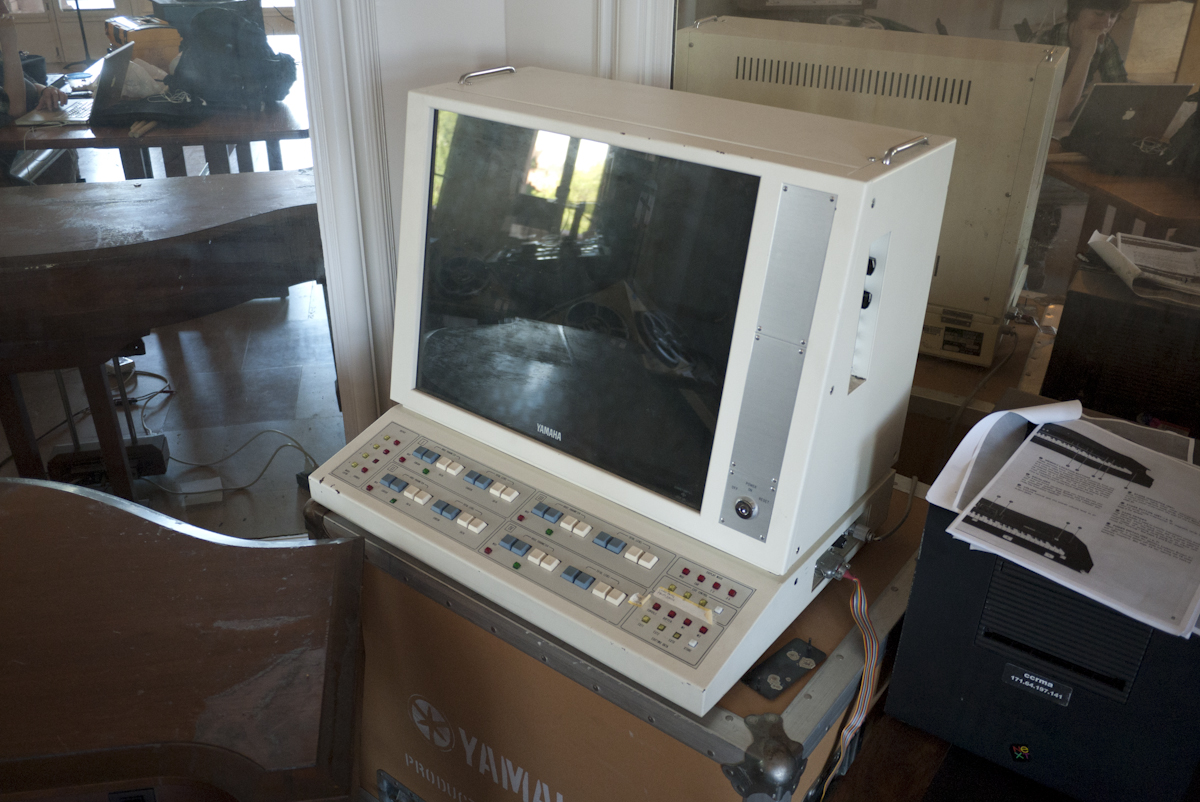|
Sonic Artifact
In sound and music production, sonic artifact, or simply artifact, refers to sonic material that is accidental or unwanted, resulting from the editing or manipulation of a sound. Types Because there are always technical restrictions in the way a sound can be recorded (in the case of acoustic sounds) or designed (in the case of synthesised or processed sounds), sonic errors often occur. These errors are termed artifacts (or sound/sonic artifacts), and may be pleasing or displeasing. A sonic artifact is sometimes a type of digital artifact, and in some cases is the result of data compression (not to be confused with dynamic range compression, which also may create sonic artifacts). Often an artifact is deliberately produced for creative reasons. For example to introduce a change in timbre of the original sound or to create a sense of cultural or stylistic context. A well-known example is the overdriving of an electric guitar or electric bass signal to produce a clipped, distort ... [...More Info...] [...Related Items...] OR: [Wikipedia] [Google] [Baidu] |
Sound
In physics, sound is a vibration that propagates as an acoustic wave through a transmission medium such as a gas, liquid or solid. In human physiology and psychology, sound is the ''reception'' of such waves and their ''perception'' by the brain. Only acoustic waves that have frequency, frequencies lying between about 20 Hz and 20 kHz, the audio frequency range, elicit an auditory percept in humans. In air at atmospheric pressure, these represent sound waves with wavelengths of to . Sound waves above 20 kHz are known as ultrasound and are not audible to humans. Sound waves below 20 Hz are known as infrasound. Different animal species have varying hearing ranges, allowing some to even hear ultrasounds. Definition Sound is defined as "(a) Oscillation in pressure, stress, particle displacement, particle velocity, etc., propagated in a medium with internal forces (e.g., elastic or viscous), or the superposition of such propagated oscillation. (b) Auditory sen ... [...More Info...] [...Related Items...] OR: [Wikipedia] [Google] [Baidu] |
Tape Hiss
Tape hiss is the high frequency noise present on analogue magnetic tape recordings caused by the size of the magnetic particles used to make the tape. Effectively it is the noise floor of the recording medium. It can be reduced by the use of finer magnetic particles or by increasing the tape speed or the track width used by the recorder. A 3 dB improvement of the signal to noise ratio occurs for every doubling of the track width. A number of noise reduction techniques can be used to reduce the impact of tape hiss, including Dolby NR and DBX, or, in the case of videotape recording, frequency modulation of either the composite video signal, or the luma component. See also * Audio quality measurement * Sound recording Sound recording and reproduction is the electrical, Mechanical system, mechanical, electronic, or digital inscription and re-creation of sound waves, such as spoken voice, singing, instrumental music, or sound effects. The two main classes of ... Ref ... [...More Info...] [...Related Items...] OR: [Wikipedia] [Google] [Baidu] |
Circuit Bending
Circuit bending is the creative customization of the circuits within electronic devices such as children's toys and digital synthesizers to create new musical or visual instruments and sound generators. Circuit bending is manipulating a circuit to get an output that was not intended by the manufacturer. Emphasizing spontaneity and randomness, the techniques of circuit bending have been commonly associated with noise music, though many more conventional contemporary musicians and musical groups have been known to experiment with "bent" instruments. Circuit bending usually involves dismantling the machine and adding components such as switches and potentiometers that alter the circuit. Experimental process ] The process of circuit bending involves experimenting with inexpensive second-hand electronics that produce sounds, such as toys, keyboards, drum machines, and electronic learning products. Innovators While Ghazala says that he was not the first circuit bender, he coi ... [...More Info...] [...Related Items...] OR: [Wikipedia] [Google] [Baidu] |
Glitch (music)
Glitch is a genre of experimental electronic music that emerged in the 1990s, which is distinguished by the deliberate use of glitches in audio media and other sonic artifacts. The sounds featured in glitch tracks usually come from audio recording device or digital electronics malfunctions, such as CD skipping, electric hum, digital or analog distortion, circuit bending, bit-rate reduction, hardware noise, software bugs, computer crashes, vinyl record hiss or scratches, and system errors, as well as abstract sound design produced from the intended use of these technologies. Devices that were already broken are often used, while other times devices are broken expressly for this purpose. In '' Computer Music Journal'', composer and writer Kim Cascone classified glitch as a subgenre of electronica and used the term ''post-digital'' to describe the glitch aesthetic."The glitch genre arrived on the back of the electronica movement, an umbrella term for alternative, largely dance ... [...More Info...] [...Related Items...] OR: [Wikipedia] [Google] [Baidu] |
Electronic Music
Electronic music broadly is a group of music genres that employ electronic musical instruments, circuitry-based music technology and software, or general-purpose electronics (such as personal computers) in its creation. It includes both music made using electronic and electromechanical means (electroacoustic music). Pure electronic instruments depend entirely on circuitry-based sound generation, for instance using devices such as an electronic oscillator, theremin, or synthesizer: no acoustic waves need to be previously generated by mechanical means and then converted into electrical signals. On the other hand, electromechanical instruments have mechanical parts such as strings or hammers that generate the sound waves, together with electric elements including pickup (music technology), magnetic pickups, power amplifiers and loudspeakers that convert the acoustic waves into electrical signals, process them and convert them back into sound waves. Such electromechanical devices in ... [...More Info...] [...Related Items...] OR: [Wikipedia] [Google] [Baidu] |
Computer Music
Computer music is the application of computing technology in music composition, to help human composers create new music or to have computers independently create music, such as with algorithmic composition programs. It includes the theory and application of new and existing computer software technologies and basic aspects of music, such as sound synthesis, digital signal processing, sound design, sonic diffusion, acoustics, electrical engineering, and psychoacoustics. The field of computer music can trace its roots back to the origins of electronic music, and the first experiments and innovations with electronic instruments at the turn of the 20th century. History Much of the work on computer music has drawn on the relationship between music and mathematics, a relationship that has been noted since the Ancient Greeks described the " harmony of the spheres". Musical melodies were first generated by the computer originally named the CSIR Mark 1 (later renamed CSIRAC) in Austra ... [...More Info...] [...Related Items...] OR: [Wikipedia] [Google] [Baidu] |
Sampler (musical Instrument)
A sampler is an electronic musical instrument that records and plays back samples (portions of sound recordings). Samples may comprise elements such as rhythm, melody, speech, sound effects or longer portions of music. The mid-20th century saw the introduction of keyboard instruments that played sounds recorded on tape, such as the Mellotron. As technology improved, cheaper standalone samplers with more memory emerged, such as the E-mu Emulator, Akai S950 and Akai MPC. Samples may be loaded or recorded by the user or by a manufacturer. The samples can be played back by means of the sampler program itself, a MIDI keyboard, sequencer or another triggering device (e.g., electronic drums). Because these samples are usually stored in digital memory, the information can be quickly accessed. A single sample may be pitch-shifted to different pitches to produce musical scales and chords. Often samplers offer filters, effects units, modulation via low frequency oscillation ... [...More Info...] [...Related Items...] OR: [Wikipedia] [Google] [Baidu] |
Aliasing
In signal processing and related disciplines, aliasing is a phenomenon that a reconstructed signal from samples of the original signal contains low frequency components that are not present in the original one. This is caused when, in the original signal, there are components at frequency exceeding a certain frequency called Nyquist frequency, f_s / 2, where f_s is the sampling frequency ( undersampling). This is because typical reconstruction methods use low frequency components while there are a number of frequency components, called aliases, which sampling result in the identical sample. It also often refers to the distortion or artifact that results when a signal reconstructed from samples is different from the original continuous signal. Aliasing can occur in signals sampled in time, for instance in digital audio or the stroboscopic effect, and is referred to as temporal aliasing. Aliasing in spatially sampled signals (e.g., moiré patterns in digital images) is referre ... [...More Info...] [...Related Items...] OR: [Wikipedia] [Google] [Baidu] |
Nyquist–Shannon Sampling Theorem
The Nyquist–Shannon sampling theorem is an essential principle for digital signal processing linking the frequency range of a signal and the sample rate required to avoid a type of distortion called aliasing. The theorem states that the sample rate must be at least twice the Bandwidth (signal processing), bandwidth of the signal to avoid aliasing. In practice, it is used to select band-limiting filters to keep aliasing below an acceptable amount when an analog signal is sampled or when sample rates are changed within a digital signal processing function. The Nyquist–Shannon sampling theorem is a theorem in the field of signal processing which serves as a fundamental bridge between continuous-time signals and discrete-time signals. It establishes a sufficient condition for a sample rate that permits a discrete sequence of ''samples'' to capture all the information from a continuous-time signal of finite Bandwidth (signal processing), bandwidth. Strictly speaking, the theorem ... [...More Info...] [...Related Items...] OR: [Wikipedia] [Google] [Baidu] |
Groove Echo
In audio signal processing, pre-echo, sometimes called a ''forward echo'' (not to be confused with reverse echo), is a digital audio compression artifact where a sound is heard before it occurs (hence the name). It is most noticeable in impulsive sounds from percussion instruments such as castanets or cymbals. It occurs in transform-based audio compression algorithms typically based on the modified discrete cosine transform (MDCT) such as MP3, MPEG-4 AAC, and Vorbis, and is due to quantization noise being spread over the entire transform window of the codec. Cause The psychoacoustic component of the effect is that one hears only the echo preceding the transient, not the one following because this latter is drowned out by the transient. Formally, forward temporal masking is much stronger than backwards temporal masking, hence one hears a pre-echo, but no post-echo. Mitigation In an effort to avoid pre-echo artifacts, many sound processing systems use filters where all of the ... [...More Info...] [...Related Items...] OR: [Wikipedia] [Google] [Baidu] |
Crackling Noise
Crackling noise arises when a system is subject to an external force and it responds via events that appear very scale invariant, similar at many different scales. In a classical system there are usually two states, on and off. However, sometimes a state can exist in between. There are three main categories this noise can be sorted into: the first is ''popping'' where events at very similar magnitude occur continuously and randomly, e.g. popcorn; the second is ''snapping'' where there is little change in the system until a critical threshold is surpassed, at which point the whole system flips from one state to another, e.g. snapping a pencil; the third is ''crackling'' which is a combination of popping and snapping, where there are some small and some large events with a relation law predicting their occurrences, referred to as Universality (dynamical systems), universality. Crackling can be observed in many natural phenomena, e.g. crumpling paper, candy wrappers (or other elastic s ... [...More Info...] [...Related Items...] OR: [Wikipedia] [Google] [Baidu] |






